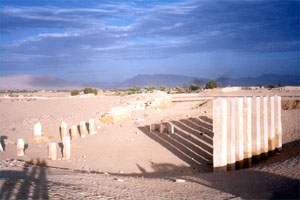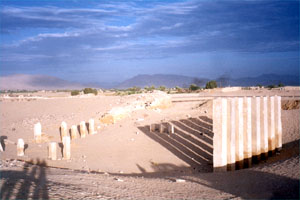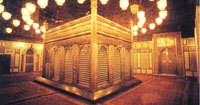
Race of Queen of the Kingdom of Sheba in Question: Was Queen Bilqees of Ethiopian Origin? [Archives:2001/05/Culture]
January 29 2001
Farouq Al-Kamali
Yemen Times
Taiz

Strangely, Dr. Abdullah Al-Sheiba, president of Taiz University, denied, in a lecture, existence of any engravings, antiquities, etc. proving that Queen Bilqees was Yemeni. “There is no agreement on her name or her travel to meet Solomon,” he added.
In his “Studies on Yemeni Ancient History”, he mentions an Ethiopian legend about their queen ‘Makida’, the world-wide famous ruler of Yemen and Ethiopia. She decided to visit King Solomon who was famous for his wisdom and kingdom. They were married and she gave birth to a baby who later on became the king of Ethiopia.
The book narrates another story about a girl called the ‘queen of the south.’ Her nation used to worship the snake. Every family had to sacrifice it’s elder daughter for the snake. When it was the turn of the ‘queen of the south’, she managed, with the help of 7 saints, to kill it. A drop of the snake’s blood fell on her leg and turned it into a donkey’s. When she was made the queen, she headed for Solomon to get back to her natural shape. There she was married to Solomon, who also, as the story tells, slept with her maid before they returned to Ethiopia. In Ethiopia both of them gave birth to two babies.
Dr. Al-Sheiba questions in his book the reality of the Queen of Sheba who came to King Solomon according to the Holy Quran and The old Testament. And who is the Queen of the South and the Queen of Good Omen who where mentioned in the Old Testament? What is their relation to Ethiopia? What were the results of their visits to Solomon, other than, gifts and converting to a new religion?
“Answers to these exclamation marks are not mentioned in the religious resources” he said. “But the two stories almost reach the same conclusion: the king of Ethiopia was Solomon’s son,” he added.
It is a well known fact that Sheba is part of Yemen and Bilqees or Makida, is known as the Queen of Sheba. In addition, Yemeni immigration is connected to Sheba land and the historic map of Marib is related to Sheba. However, one cannot be confident;y sure about the date of the emergence of the Sheba civilization.
To make things more clear, we also met with Dr. Muttahar Al-Iryani, Mr. Al-Izzy Mosleh and Mr. Mohammed Hussein Al-Farih.
“Yemen was certainly ruled by a queen in the 10th Century AD. Her throne was placed in Marib. Neither the Holy Quran nor The New Testament identified her name nor we have been able to find any engraving dated back to the same era. However, that does not mean that the Queen is a mere fabrication. There are still a lot of buried engravings which have not seen the light of the day yet. All the engravings that have so far been discovered date back to later eras. Hopefully we will make more important discoveries dating back to the 10th Century AD, and even before that when scientific excavations are carried out. The future-planned excavations will certainly give us more evidence and more details about the existence of the queen. Researchers should not deny the existence of a Yemeni Queen, for the Holy Quran clearly points to the story of a queen that ruled Yemen. We have to look for more evidence,” said Muttahar Al-Iryani.
The manager of the Taiz Antiquities Office, Mr. Al-Izzy Mohammed Mosleh said in response to whether Bilqees is Yemeni or Ethiopian,: “The Ethiopian civilization emerged in the 5th Century AD. The visit of the queen to the king Solomon took place in 950 AD. This means that there is a difference of about 450 years between the Ethiopian civilization and the visit. This can prove that the queen is not Ethiopian. All evidences suggests that the Sheba land lies in the south of the Arabian Peninsula and the engravings discovered in Marib indicate kings of Sheba.
The Holy Quran ‘Bait’: “I (the hoopoe to Solomon) have come to you from Saba (Sheba) with true news,” and the other Quranic indications about the land of two gardens and Marib Dam are all indications of the fact that Sheba and Sheba land are Marib. Besides, Orientalists confirmed that Sheba land is in the Arabian Peninsula.”
In an interesting speech about the Civilization of Sheba, its queen and her visit to King Solomon, Mr. Mohammed Hussain Al-Farih, a member of the Arab Historians Union, said: “Some doubts have been shed on the reality of the Queen of Sheba , whether she was the queen of Yemen or the queen of Abyssinia and what evidence is their for her name,””In my opinion, the basic thing to be discovered is the real location of the Sheba Queendom. It was known to the ancient Greek and Roman historians who identified its location. They talked about Egypt, Babylon and Ethiopia. They also mentioned that that Sheba Queendom lay in the South of the Arabian Peninsula (Arabia Felix)
“Sheba is the most fertile land in Arabia Felix and its capital, Marib is a great city,” writes an orientalist. ” Arabia Felix exudes perfumes and incense. It produces frankincense, myrrh, cinnamon, etc.,” writes another AD. Agatharchides writes: “There is everything that can make you happy in Sheba. The people of Sheba are among the richest in the world. They trade in Arab and Indian goods which they took in caravans to the west. they have also huge ships crossing the Indian Ocean.”
‘Planus’ allocated a whole chapter in his book “Natural History” to Arabia Felix. In this chapter he excessively talks about Sheba, Myrrh and incense production, and the caravans’ route to Gaza.
The Greek and Roman maps including Patlimos’ 190, located Arabia felix , in which it identified Sheba land as Sheba. Meanwhile, Ethiopia was identified by its real name or Abyssinia,” he added.
In response to a question about the engravings which prove that Bilqees was the Queen of Sheba, he said: “Marib was the capital of Sheba. Its traces are still there. Some orientalists have been doubtful about the Queen of Sheba and her visit to Solomon saying that the civilization of the south of the Arabian Peninsula dates back to 5th Century AD, while Solomon lived in 10th Century AD. However, the new discoveries have refuted this, showing that civilization of the Marib dam dates back to 2000 AD.
The German Archaeological Institute’s excavations in the location of the historic dam of Marib showed that the dam’s sections date back to 2000 AD. A huge section to distribute water dating back to the 8th Century AD, was also discovered. The German expedition described the dam as a titanic Sabaean institution that survived thousands of years.
An American expedition, headed by Dr. James S. from the university of Pennsylvania in 1985 came across antiquities dating back to the 13th and 14th century AD. This proves that the Sheba kingdom civilization is more ancient than people think.
It was believed that Baran Temple (Arsh Bilqees) and Ilmaqa Temple (Mahram Bilqees) dated back to the 5th Century AD. However, discoveries by the German expedition led to the conclusion that the temple dates back to the beginning of the 10th Century AD. Other scripts found in Marib dam, Pennsylvania Temple, Mahram Bilqees, Sirwah, Naa’it, Amran, Dhafar, etc. which were copied by the American expedition in 1952 and were published by Albert Gam in “Sabaean Scripts in Mahram Bilqees” date back to the same period.
Studies show that the kings of Sheba lived between (835-1220 AD). The calendar used was a Sabaean one and the first year of it agrees with 1220 AD. This year mark the emergence of the Sabaean kingdom under the leadership of Pennsylvania Dhi Riash after whom one of the temples was named,” he continued.
Al-Farih said that Queen Bilqees was put on the throne as the 17th ruler of Yemen in Silheen Palace of Marib in the middle of the 10th century AD. Sabaean kings and queen were described by Ben Khaldoon as the kings of Yemen as well as the Arab Peninsula. And Al-Masawdi described them as the crown of the earth.
In an interpretation of the Holy Verse “But the hoopoe stayed not long: he (came up and) said: “I have grasped (the knowledge of a thing ) which you have not grasped and I have come to you from Saba (Sheba) with true news. “I found a woman ruling over them: she has been given all things that could be possessed by any ruler of the earth, and she has a great throne” Ibn Kathier says it tells the greatness of the Sabaean kingdom and queendom.
All scripts, engravings and studies confirm that the Sabaeans ruled the whole Yemen. In Hamed Abduqader’s “The Sublime Nations” he mentions that Sheba land extended to the north of the Arabian Peninsula under the leadership of Taghlat and Sarjon. He adds that during the reign of Queen Bilqees the borders of the queendom were bounded by those of Solomon’s.
“The scripts found in Maan and Lower Euphrates prove that they were ruled by the Sabaeans,” says Dr. Adnan Tarsisi, adding that the rule of Sabaeans over these districts was over in 640 AD. The ‘Kildaneans’ who settled down in Babylon originally derived from the Sabaeans, and later on they ruled it. Dr. Sami Al-Ahmad says in his book, Alloghat Al-Gazriah” that the Sabaeans and kildaneans are originally from Yemen. This was proved by the scripts found in Babylon in Iraq which were written in the old Yemeni font (Mosnad).
An old Chinese script, translated by A. Forke, documented the visit of the Chinese King, Muvon Chou, to the south of the Arabian Peninsula in the middle of the 10th Century AD. Forke added that the visiting king arrived in the queen’s palace with his scepter and was warmly received by the Queen. He gave her a lot of presents.
The rule of the Queen Bilqees extended over the Ethiopian plateau and the Kildaneans in Babylon. Later on, the Kildaneans established their own kingdom of which Nabokhadh Nassar (605-562) AD was the greatest. One of Nabokhadh’s contemporary figures was Yashoa Ben Sirakh. .In “Alphabetum Siracids”, a book compiling the Yashoa’s words, it was mentioned that the King Nabokhadh Nassar was the son of the Queen who visited King Solomon. However, the marriage of Solomon and Queen of Sheba is not certain because none of the Holy Books mention it.
About the Queen’s visit to King Solomon, as mentioned in the holy Quran, Al-Farih said: “The Holy Quran registered all events that took place before the visit and before she said: “I am going to send him a present, and see with what (answer) the messengers return.” “History resources tell that the delegation sent to Solomon did not only return with Solomon’s answer which rejected the present but also with details about his wisdom, religion, strength and his supernatural powers. She did not believe all this stuff and, thus, decided to visit him.”
In 931 AD, the queen left her Queendom to meet Solomon with a huge army. She was riding a golden carriage followed by caravans loaded with gold and precious stones. The aim of the delegation was to prove that Sheba was the strongest and richest queendom. The Torah begins the story of the visit to Jerusalem by describing the great procession and presents and gifts carried.
“The American expedition which carried out excessive excavations in Mahram Bilqees in 1952 came across a script bearing the name of Bilqees,” said Al-Farih. Head of the expedition, Dr. Windle Philips, in his book “Bilqees’ Treasures” says that he found a number of scripts and engravings which included the name of Bilqees.
What is the real name of Queen of Sheba?
The Ethiopians called their queen Makida ,but the most famous name for queen of Sheba is Bilqees.
Montgomery Watt, an orientalist, related the name to the Greek word ‘Pallakis’ which means ‘a lover girl’. This comparison was also adopted by the German orientalist Ghostaf Roch and the French Scholar Kardi F. Drami, Another French scholar did not agree with them saying that the word combined two parts which mean the ‘girl of the treasure’. Others say it means the ‘honey girl,'” said Al-Farih. “However,” he added, “The name should be connected to kings of Sheba and the engravings available. the name is made of ‘Bilq’ or ‘Balq’ and ‘Iees’. According to the Al-Muheet Arabic Dictionary, ‘Balq’ means whiteness and ‘Bilq’ means sharp redness while ‘Iees’ is the god of the Sun. Thus Bilqees means ‘the redness and whiteness bestowed by the god of the Sun’ or ‘the women of the sun beauty’ or ‘of the divine beauty.’
Dr. Muttahar Al-Iryani thinks differently. In his opinion, the ‘Be’ is a preposition and ‘Qais’ is another name for the greatest god of Sabaeans ‘Ilmaqah’.
“Belgesh in the Hebraic means ‘the beautiful woman,'” said Al-Izzi Mosleh. “Today the world recognizes, even in songs, that queen of Sheba means the beautiful woman,” he added.
It is at least certain that queen Bilqees is the Queen of Sheba the capital of which was Marib. There might be different opinions about and disagreements with the name of the queen but the most important is that she lived in Yemen and ruled the Sheba land. This proves that the Queen of Sheba was Yemeni.
——
[archive-e:05-v:2001-y:2001-d:2001-01-29-p:./2001/iss05/culture.htm]


